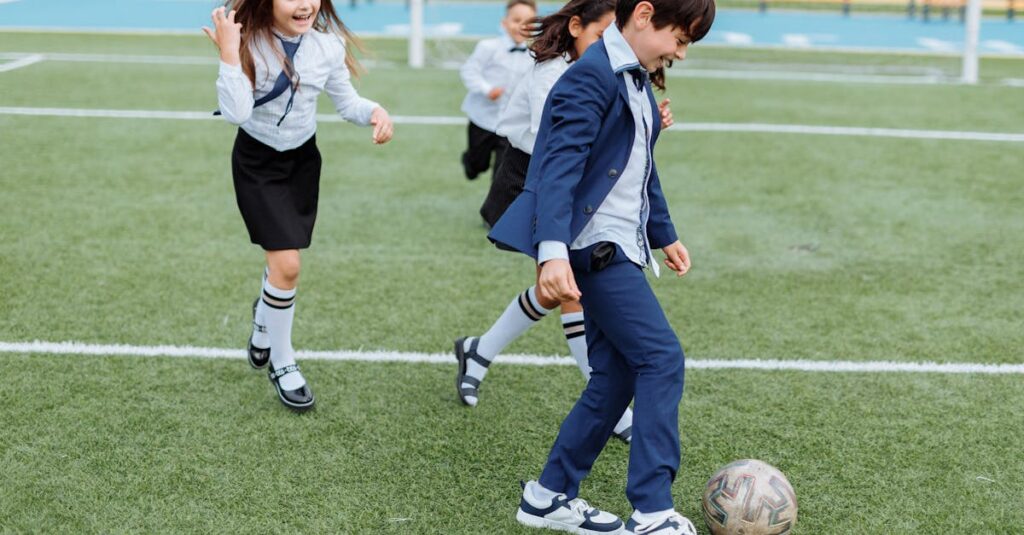Goal setting is a powerful tool that can shape the future of elementary students. By learning to set achievable goals early on, children develop essential skills like focus, determination, and resilience. These skills not only enhance their academic performance but also prepare them for challenges beyond the classroom.
In a world filled with distractions, teaching kids how to set and pursue their goals can lead to greater self-confidence and a sense of accomplishment. Whether it’s mastering a new math concept or improving their reading skills, goal setting empowers students to take ownership of their learning journey. With the right guidance, young learners can transform their aspirations into tangible achievements.
Goal Setting For Elementary Students
Goal setting fosters essential skills in elementary students. It enhances focus by encouraging children to concentrate on specific objectives. Setting clear goals aids determination, motivating students to persist through challenges. The practice of achieving these goals builds resilience, teaching the value of effort and recovery from setbacks.
By establishing achievable targets, students can track their progress, boosting self-confidence with each accomplishment. This sense of achievement not only improves academic performance but also equips children with tools for future endeavors. In an environment filled with distractions, goal setting cultivates a proactive attitude towards learning.
Overall, instilling goal-setting habits early empowers students to take ownership of their education. It prepares them for lifelong success by transforming aspirations into tangible results.
Types Of Goals
Setting goals involves various types, specifically short-term and long-term goals. Each type serves distinct purposes in the learning process and contributes differently to students’ development.
Short-Term Goals
Short-term goals focus on immediate, achievable objectives. They usually cover tasks that students can complete within days or weeks. Examples include:
- Completing Homework: Finishing all assigned tasks by the due date.
- Improving Reading Skills: Reading one book per week to enhance comprehension.
- Participating in Class: Raising a hand and answering questions during each lesson.
These goals help students experience quick wins, boosting their confidence and motivation. Tracking progress on short-term goals reinforces good habits and provides a sense of accomplishment.
Long-Term Goals
Long-term goals target broader, more aspirational objectives extending over months or years. Examples include:
- Achieving Academic Excellence: Maintaining a grade point average of 3.5 or higher by the end of the academic year.
- Mastering a Skill: Developing proficiency in a musical instrument over the school year.
- Planning for Future Education: Researching high schools and their programs by the end of the eighth grade.
Long-term goals require ongoing commitment and perseverance. They foster a growth mindset, encouraging students to work steadily towards their aspirations while acknowledging the necessary steps along the way. Tracking milestones along the journey enhances motivation and keeps students aligned with their goals.
Strategies For Effective Goal Setting
Effective goal setting involves clear strategies that help students stay focused and motivated. Incorporating structured frameworks and involving family can significantly enhance this process.
SMART Goals Framework
Utilizing the SMART goals framework can strengthen students’ goal-setting skills. This model encourages goals that are Specific, Measurable, Achievable, Relevant, and Time-bound.
- Specific: Define clear, precise goals. For example, “Read three new books this month” instead of “Read more.”
- Measurable: Ensure progress can be tracked. Goals like “Complete five math problems daily” allow for easy assessment.
- Achievable: Set realistic goals. Students should consider their current abilities, aiming for challenges within reach, such as “Improve spelling test score by five points.”
- Relevant: Align goals with personal interests. Focusing on subjects students enjoy increases motivation, like “Join the school chess club.”
- Time-bound: Assign deadlines. Short-term goals, such as “Finish the science project by next Friday,” create urgency.
Involving Parents In The Process
Engaging parents in the goal-setting process enhances accountability and support. Parents can help students articulate their goals and provide encouragement throughout the journey.
- Discuss Goals: Regular conversations about goals foster understanding and commitment. Parents can ask about students’ aspirations during dinner or family meetings.
- Monitor Progress: Establish checkpoints for progress evaluation. Parents can assist by reviewing completed assignments or providing feedback on projects.
- Celebrate Achievements: Recognize accomplishments together, no matter how small. Celebrating milestones, like completing a reading challenge, boosts morale and reinforces positive behavior.
- Encourage Reflection: Guide students to reflect on their experiences. Parents can facilitate discussions about what worked, what didn’t, and how to adjust future goals.
Challenges In Goal Setting For Elementary Students
Elementary students encounter various challenges when setting and pursuing goals. Addressing these obstacles helps students remain focused and engaged in their learning journey.
Overcoming Procrastination
Procrastination presents a significant hurdle for young learners. Students often delay tasks due to distractions, lack of motivation, or feeling overwhelmed. Breaking tasks into smaller, manageable steps simplifies the process and reduces anxiety. Creating structured timelines, using checklists, and employing timers can help students stay on track. Accountability partners, such as teachers or parents, can encourage timely progress by regularly checking in on goals.
Dealing With Setbacks
Setbacks can be frustrating for elementary students. Encountering difficulties, whether academic or personal, may lead to loss of confidence. Encouraging a growth mindset helps students view challenges as opportunities to learn. Teaching students to analyze their setbacks fosters resilience, allowing them to develop problem-solving skills. Celebrating small victories reinforces perseverance and cultivates a positive outlook, emphasizing that failure is a natural part of the learning process.
Goal setting is a vital skill for elementary students that lays the foundation for future success. By learning to set and pursue goals, children not only enhance their academic abilities but also develop essential life skills such as resilience and determination.
Engaging parents in this process creates a supportive environment that fosters motivation and accountability. As students navigate challenges and celebrate achievements, they build self-confidence and a sense of ownership over their learning.
Ultimately, instilling these practices early on prepares children to embrace their aspirations and turn them into reality, equipping them for lifelong growth and fulfillment.

